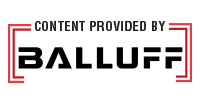
Water is everywhere, in most things living and not, and the amount of this precious resource is always important. The simplest form of monitoring water is if it is there or not. In your body, you feel the effects of dehydration, in your car the motor overheats, and on your lawn, you see the dryness of the grass. What about your specialty machine or your assembly process? Water and other liquids are inherently clear so how do you see them, especially small amounts of it possibly stored in a tank or moving fast? Well, there are several correct answers to that question. Let’s dive into this slippery topic together, pun intended.
While mechanical float and flow switches have been around the longest, capacitive, photoelectric, and ultrasonic sensors are the most modern forms of electronic water detection. These three sensing technologies all have their strong points. Let’s cover a few comparisons that might help you find your path to the best solution for your application.
Capacitive sensors
Capacitive sensors are designed to detect nonferrous materials, but really anything that can break the capacitive field the sensor creates, including water, can do this. This technology allows for adjustment to the threshold of what it takes to break this field. These sensors are a great solution for through tank level detection and direct-contact sensing.
Ultrasonic sensors
Want to view your level from above? Ultrasonic sensors give you that view. They use sound to bounce off the media and return to the sensor, calculating the time it takes to measure distance. Their strong point is that they can overcome foam and can bounce off the water where light struggles when there is a large distance from the target to the receiver. Using the liquid from above, ultrasonics can monitor large tanks without contact.
Photoelectric sensors
Use photoelectric sensors when you’re looking at a solution for small scale. Now, this might require a site tube if you are monitoring the level on a large tank, however, if you want to detect small amounts of water or even bubbles within that water, photoelectric sensors are ideal. Using optical head remote photoelectric sensors tied to an amplifier, the detail and speed are unmatched. Photoelectric sensors are also great at detecting liquid levels on transparent bottles. In these applications with short distances, you need speed. Photoelectric sensors are as fast as light.
So, have you made up your mind yet? No matter which technology you choose, you will have a sensor that gives you accurate detail and digital outputs and is easy on the budget. Capacitive, ultrasonic, and photoelectric sensors provide all this and they grow with your application with adjustability.
Liquids are everywhere and not going away in manufacturing. They will continue to be an important resource for manufacturing. Cherish them and ensure that you account for every drop.


